前言:
最近因为工作中业务需要,代码里用了大量的if else嵌套。想着如何优化,刚好在网上看到一篇文章,个人觉得写的还不错。这边转载过来以后后续学习。根据个人理解和需要,自己做了一点修改整理。
作者:leowudev 原文:http://www.apkbus.com/blog-970703-78964.html(已征得原文作者同意,后续转载需注明来源!!!)
写在前面:
不知大家有没遇到过像“横放着的金字塔”一样的if else嵌套:
1 if (true) { 2 if (true) { 3 if (true) { 4 if (true) { 5 if (true) { 6 if (true) { 7 8 } 9 } 10 } 11 } 12 } 13 }
我并没夸大其词,我是真的遇到过了!嵌套6、7层,一个函数几百行,简!直!看!死!人!
if else作为每种编程语言都不可或缺的条件语句,我们在编程时会大量的用到。但if else一般不建议嵌套超过三层,如果一段代码存在过多的if else嵌套,代码的可读性就会急速下降,后期维护难度也大大提高。所以,我们程序员都应该尽量避免过多的if else嵌套。下面将会谈谈我在工作中如何减少if else嵌套的。
正文:
在谈我的方法之前,不妨先用个例子来说明if else嵌套过多的弊端。
想象下一个简单分享的业务需求:支持分享链接、图片、文本和图文,分享结果回调给用户(为了不跑题,这里简略了业务,实际复杂得多)。当接手到这么一个业务时,是不是觉得很简单,稍动下脑就可以动手了:
先定义分享的类型、分享Bean和分享回调类:
1 private static final int TYPE_LINK = 0; 2 private static final int TYPE_IMAGE = 1; 3 private static final int TYPE_TEXT = 2; 4 private static final int TYPE_IMAGE_TEXT = 3; 5 6 public class ShareItem { 7 int type; 8 String title; 9 String content; 10 String imagePath; 11 String link; 12 } 13 14 public interface ShareListener { 15 16 int STATE_SUCC = 0; 17 int STATE_FAIL = 1; 18 19 void onCallback(int state, String msg); 20 }
好了,然后在定义个分享接口,对每种类型分别进行分享就ok了:
1 public void share (ShareItem item, ShareListener listener) { 2 if (item != null) { 3 if (item.type == TYPE_LINK) { 4 // 分享链接 5 if (!TextUtils.isEmpty(item.link) && !TextUtils.isEmpty(item.title)) { 6 doShareLink(item.link, item.title, item.content, listener); 7 } else { 8 if (listener != null) { 9 listener.onCallback(ShareListener.STATE_FAIL, "分享信息不完整"); 10 } 11 } 12 } else if (item.type == TYPE_IMAGE) { 13 // 分享图片 14 if (!TextUtils.isEmpty(item.imagePath)) { 15 doShareImage(item.imagePath, listener); 16 } else { 17 if (listener != null) { 18 listener.onCallback(ShareListener.STATE_FAIL, "分享信息不完整"); 19 } 20 } 21 } else if (item.type == TYPE_TEXT) { 22 // 分享文本 23 if (!TextUtils.isEmpty(item.content)) { 24 doShareText(item.content, listener); 25 } else { 26 if (listener != null) { 27 listener.onCallback(ShareListener.STATE_FAIL, "分享信息不完整"); 28 } 29 } 30 } else if (item.type == TYPE_IMAGE_TEXT) { 31 // 分享图文 32 if (!TextUtils.isEmpty(item.imagePath) && !TextUtils.isEmpty(item.content)) { 33 doShareImageAndText(item.imagePath, item.content, listener); 34 } else { 35 if (listener != null) { 36 listener.onCallback(ShareListener.STATE_FAIL, "分享信息不完整"); 37 } 38 } 39 } else { 40 if (listener != null) { 41 listener.onCallback(ShareListener.STATE_FAIL, "不支持的分享类型"); 42 } 43 } 44 } else { 45 if (listener != null) { 46 listener.onCallback(ShareListener.STATE_FAIL, "ShareItem 不能为 null"); 47 } 48 } 49 }
到此,简单的分享模型就做出来了。有没问题?老实说,如果没什么追求的话,还真没什么问题,至少思路是清晰的。但一周后呢?一个月后呢?或者一年后呢?share方法的分支有15条,这意味着你每次回看代码得让自己的大脑变成微型的处理器,考虑15种情况。如果出现bug,你又得考虑15种情况,并15种情况都要测试下。再如果现在需要加多分享小视频功能,你又得添加多3个分支,还要改代码,一点都不“开放-闭合”。再再如果后面项目交接给他人跟进,他人又要把自己大脑变成处理器来想每个分支的作用,我敢肯定有百分之八十的人都会吐槽代码。
我们程序员的脑力不应该花费在无止境的分支语句里的,应该专注于业务本身。所以我们很有必要避免写出多分支嵌套的语句。好的,我们来分析下上面的代码多分支的原因:
-
空值判断
-
业务判断
-
状态判断
几乎所有的业务都离不开这几个判断,从而导致if else嵌套过多。那是不是没办法解决了?答案肯定不是的。
上面的代码我是用java写的,对于java程序员来说,空值判断简直使人很沮丧,让人身心疲惫。上面的代码每次回调都要判断一次listener是否为空,又要判断用户传入的ShareItem是否为空,还要判断ShareItem里面的字段是否为空……
对于这种情况,我采用的方法很简单:接口分层。
减少 if else 方法一:接口分层
所谓接口分层指的是:把接口分为外部和内部接口,所有空值判断放在外部接口完成,只处理一次;而内部接口传入的变量由外部接口保证不为空,从而减少空值判断。
来,看代码更加直观:
1 public void share(ShareItem item, ShareListener listener) { 2 if (item == null) { 3 if (listener != null) { 4 listener.onCallback(ShareListener.STATE_FAIL, "ShareItem 不能为 null"); 5 } 6 return; 7 } 8 9 if (listener == null) { 10 listener = new ShareListener() { 11 @Override 12 public void onCallback(int state, String msg) { 13 Log.i("DEBUG", "ShareListener is null"); 14 } 15 }; 16 } 17 18 shareImpl(item, listener); 19 } 20 21 private void shareImpl (ShareItem item, ShareListener listener) { 22 if (item.type == TYPE_LINK) { 23 // 分享链接 24 if (!TextUtils.isEmpty(item.link) && !TextUtils.isEmpty(item.title)) { 25 doShareLink(item.link, item.title, item.content, listener); 26 } else { 27 listener.onCallback(ShareListener.STATE_FAIL, "分享信息不完整"); 28 } 29 } else if (item.type == TYPE_IMAGE) { 30 // 分享图片 31 if (!TextUtils.isEmpty(item.imagePath)) { 32 doShareImage(item.imagePath, listener); 33 } else { 34 listener.onCallback(ShareListener.STATE_FAIL, "分享信息不完整"); 35 } 36 } else if (item.type == TYPE_TEXT) { 37 // 分享文本 38 if (!TextUtils.isEmpty(item.content)) { 39 doShareText(item.content, listener); 40 } else { 41 listener.onCallback(ShareListener.STATE_FAIL, "分享信息不完整"); 42 } 43 } else if (item.type == TYPE_IMAGE_TEXT) { 44 // 分享图文 45 if (!TextUtils.isEmpty(item.imagePath) && !TextUtils.isEmpty(item.content)) { 46 doShareImageAndText(item.imagePath, item.content, listener); 47 } else { 48 listener.onCallback(ShareListener.STATE_FAIL, "分享信息不完整"); 49 } 50 } else { 51 listener.onCallback(ShareListener.STATE_FAIL, "不支持的分享类型"); 52 } 53 }
可以看到,上面的代码分为外部接口share和内部接口shareImpl,ShareItem和ShareListener的判断都放在share里完成,那么shareImpl就减少了if else的嵌套了,相当于把if else分摊了。这样一来,代码的可读性好很多,嵌套也不超过3层了。
但可以看到,shareImpl里还是包含分享类型的判断,也即业务判断,我们都清楚产品经理的脑洞有多大了,分享的类型随时会改变或添加。嗯说到这里相信大家都想到用多态了。多态不但能应付业务改变的情况,也可以用来减少if else的嵌套。
减少 if else 方法二:多态
利用多态,每种业务单独处理,在接口不再做任何业务判断。把ShareItem抽象出来,作为基础类,然后针对每种业务各自实现其子类:
1 public abstract class ShareItem { 2 int type; 3 4 public ShareItem(int type) { 5 this.type = type; 6 } 7 8 public abstract void doShare(ShareListener listener); 9 } 10 11 public class Link extends ShareItem { 12 String title; 13 String content; 14 String link; 15 16 public Link(String link, String title, String content) { 17 super(TYPE_LINK); 18 this.link = !TextUtils.isEmpty(link) ? link : "default"; 19 this.title = !TextUtils.isEmpty(title) ? title : "default"; 20 this.content = !TextUtils.isEmpty(content) ? content : "default"; 21 } 22 23 @Override 24 public void doShare(ShareListener listener) { 25 // do share 26 } 27 } 28 29 public class Image extends ShareItem { 30 String imagePath; 31 32 public Image(String imagePath) { 33 super(TYPE_IMAGE); 34 this.imagePath = !TextUtils.isEmpty(imagePath) ? imagePath : "default"; 35 } 36 37 @Override 38 public void doShare(ShareListener listener) { 39 // do share 40 } 41 } 42 43 public class Text extends ShareItem { 44 String content; 45 46 public Text(String content) { 47 super(TYPE_TEXT); 48 this.content = !TextUtils.isEmpty(content) ? content : "default"; 49 } 50 51 @Override 52 public void doShare(ShareListener listener) { 53 // do share 54 } 55 } 56 57 public class ImageText extends ShareItem { 58 String content; 59 String imagePath; 60 61 public ImageText(String imagePath, String content) { 62 super(TYPE_IMAGE_TEXT); 63 this.imagePath = !TextUtils.isEmpty(imagePath) ? imagePath : "default"; 64 this.content = !TextUtils.isEmpty(content) ? content : "default"; 65 } 66 67 @Override 68 public void doShare(ShareListener listener) { 69 // do share 70 } 71 }
(注意:上面每个子类的构造方法还对每个字段做了空值处理,为空的话,赋值default,这样如果用户传了空值,在调试就会发现问题。)
实现了多态后,分享接口的就简洁多了:
public void share(ShareItem item, ShareListener listener) { if (item == null) { if (listener != null) { listener.onCallback(ShareListener.STATE_FAIL, "ShareItem 不能为 null"); } return; } if (listener == null) { listener = new ShareListener() { @Override public void onCallback(int state, String msg) { Log.i("DEBUG", "ShareListener is null"); } }; } shareImpl(item, listener); } private void shareImpl (ShareItem item, ShareListener listener) { item.doShare(listener); }
嘻嘻,怎样,内部接口一个if else都没了,是不是很酷~ 如果这个分享功能是自己App里面的功能,不是第三方SDK,到这里已经没问题了。但如果是第三方分享SDK的功能的话,这样暴露给用户的类增加了很多(各ShareItem的子类,相当于把if else抛给用户了),用户的接入成本提高,违背了“迪米特原则”了。
处理这种情况也很简单,再次封装一层即可。把ShareItem的子类的访问权限降低,在暴露给用户的主类里定义几个方法,在内部帮助用户创建具体的分享类型,这样用户就无需知道具体的类了:
1 public ShareItem createLinkShareItem(String link, String title, String content) { 2 return new Link(link, title, content); 3 } 4 5 public ShareItem createImageShareItem(String ImagePath) { 6 return new Image(ImagePath); 7 } 8 9 public ShareItem createTextShareItem(String content) { 10 return new Text(content); 11 } 12 13 public ShareItem createImageTextShareItem(String ImagePath, String content) { 14 return new ImageText(ImagePath, content); 15 }
或者有人会说,这样用户也需额外了解多几个方法。我个人觉得让用户了解多几个方法好过了解多几个类,而已方法名一看就能知道意图,成本还是挺小,是可以接受的。
其实这种情况,更多人想到的是使用工厂模式。嗯,工厂模式能解决这个问题(其实也需要用户额外了解多几个type类型),但工厂模式难免又引入分支,我们可以用Map消除分支。
以上,由于转载的代码结构不是很清晰,为了后续学习的时候能更清楚理解,我自己把这部分代码整理了一下。
目录结构:

分享的类型:
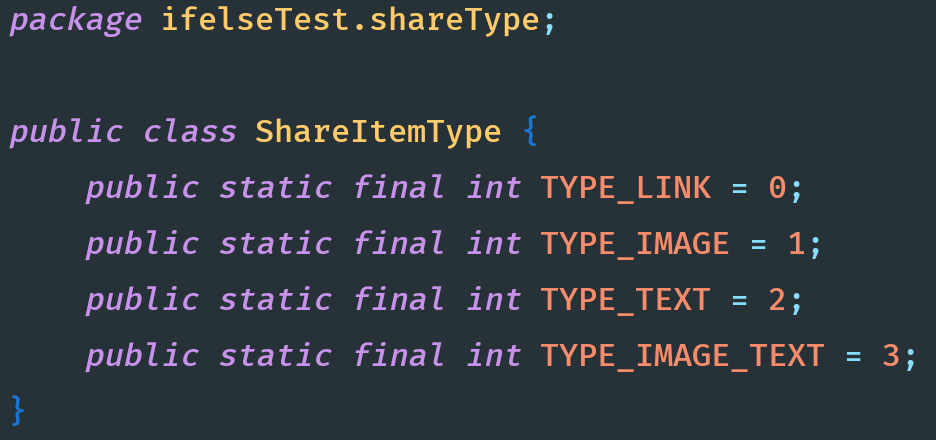
回调类:

定义一个ShareItem的抽象类:

具体的实现类:
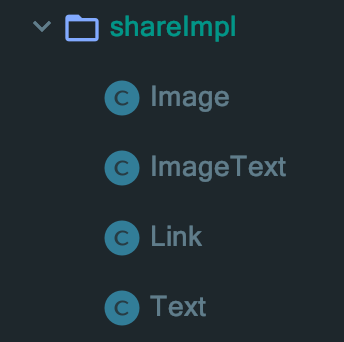

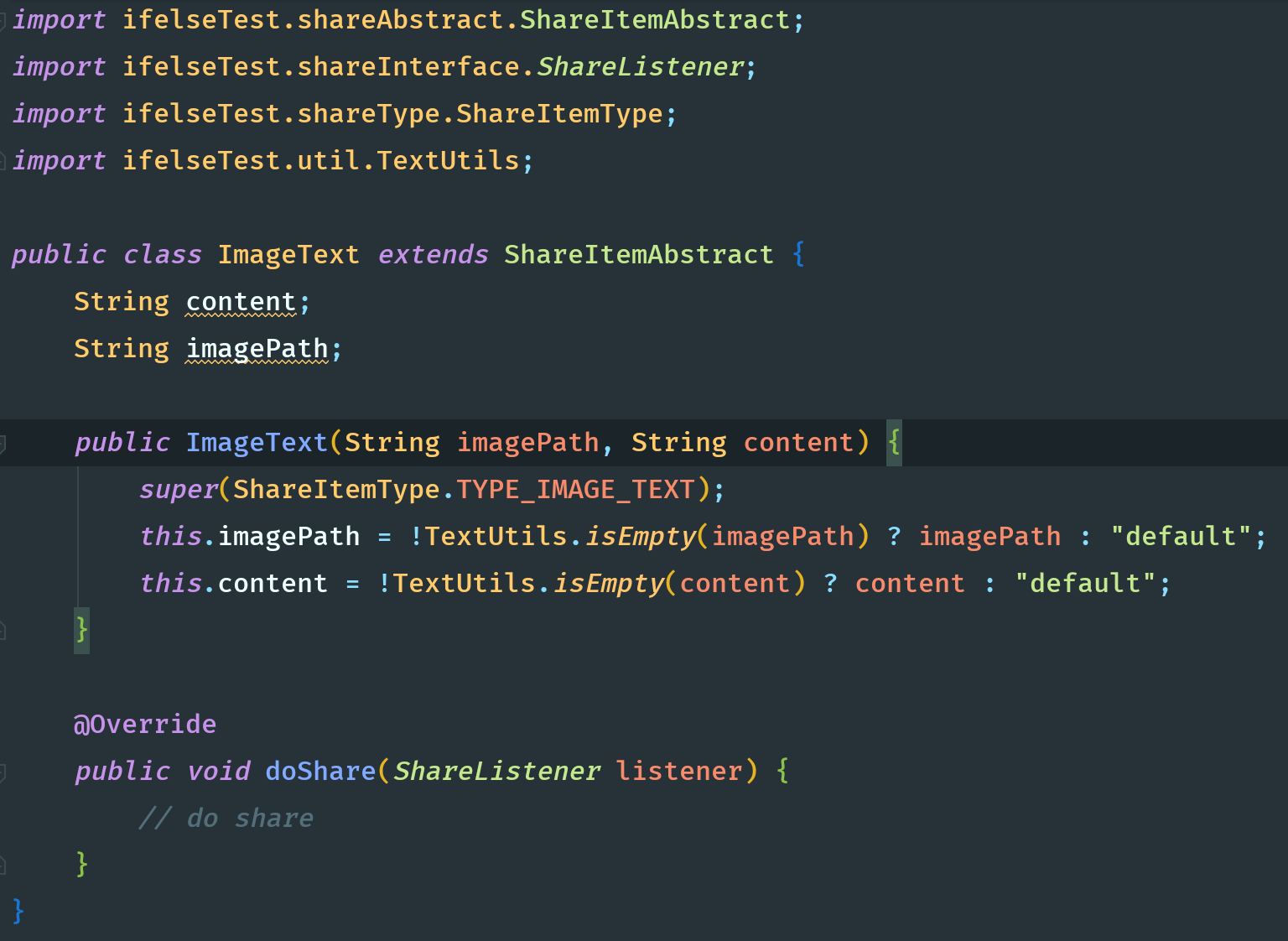

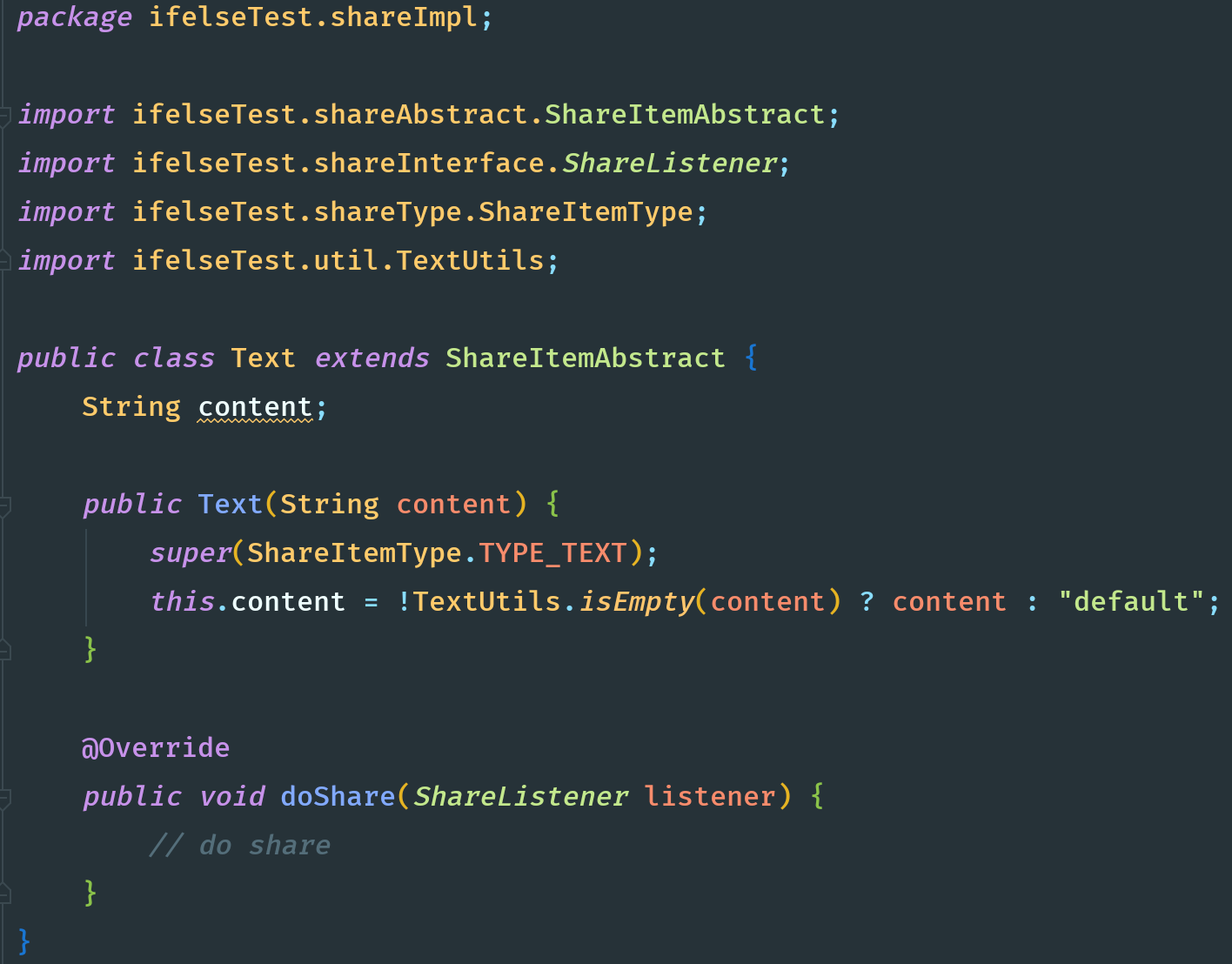
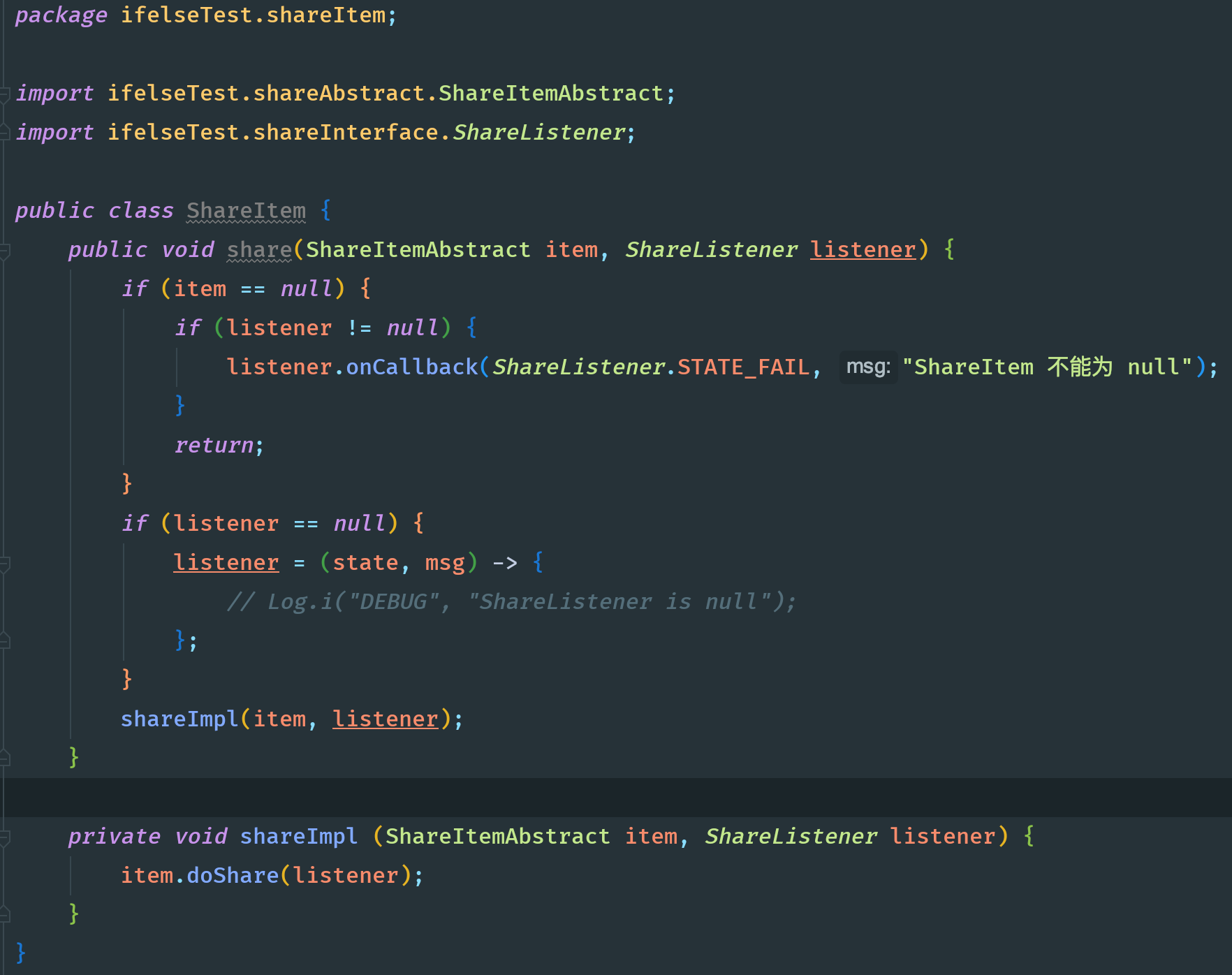

减少 if else 方法三:使用Map替代分支语句
把所有分享类型预先缓存在Map里,那么就可以直接get获取具体类型,消除分支:
1 private Map<Integer, Class<? extends ShareItem>> map = new HashMap<>(); 2 3 private void init() { 4 map.put(TYPE_LINK, Link.class); 5 map.put(TYPE_IMAGE, Image.class); 6 map.put(TYPE_TEXT, Text.class); 7 map.put(TYPE_IMAGE_TEXT, ImageText.class); 8 } 9 10 public ShareItem createShareItem(int type) { 11 try { 12 Class<? extends ShareItem> shareItemClass = map.get(type); 13 return shareItemClass.newInstance(); 14 } catch (Exception e) { 15 return new DefaultShareItem(); // 返回默认实现,不要返回null 16 } 17 }
这种方式跟上面分为几个方法的方式各有利弊,看大家取舍了~
转载于:https://www.cnblogs.com/zhongjunbo555/p/11394572.html
最后
以上就是兴奋啤酒最近收集整理的关于优化过多的if else嵌套前言:写在前面:正文:的全部内容,更多相关优化过多的if内容请搜索靠谱客的其他文章。








发表评论 取消回复